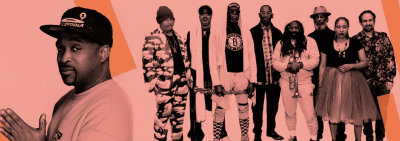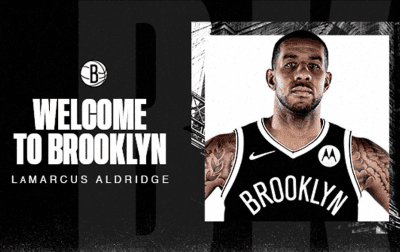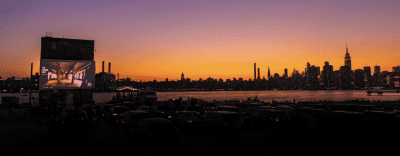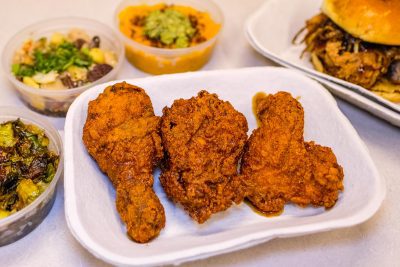Uhuru Sasa Shule kids posing outside the school (Photo by Osei T. Chandler)
Exploring the lasting legacy of The East, Central Brooklyn’s pan-African movement
In a new documentary, filmmakers Tayo and Cynthia Gordy Giwa finally tell the whole story of The East
The term “food co-op” may conjure images of Birkenstocked Park Slopers picking over bouquets of locally grown fiddlehead ferns. But in 1970s Brooklyn, The East— a pan-African organization created in 1969 by young adults in Bed-Stuy — was pioneering a vision that was altogether more radical.
“They were ahead of their time. Black people running a food co-op that long ago in Bed-Stuy is not something that’s in the public imagination,” says Tayo Giwa, director and co-writer with his wife Cynthia Gordy Giwa of “The Sun Rises in The East,” a new documentary about The East.
Led by educator and activist Jitu Weusi, The East embodied Black self-determination and would build more than a dozen institutions, lighting an entrepreneurial spark that still burns in people like the Giwas, who publish the online resource Black-Owned Brooklyn.
The Giwas interviewed many of The East’s founding members to share their stories in the documentary and included archival footage of luminaries like Max Roach, Betty Carter, Sun Ra, Pharoah Sanders, Roy Ayers and James Mtume. The resulting documentary turns the lore around The East’s sacred into history that anyone can watch.
“The East was a culmination of people saying, ‘We have all this talent and brilliance in our community. Why are we not looking at ourselves and embracing our own culture and excellence?’” says Tayo Giwa. “What they did was psychic. It was like a switch that they turned on inside of people in this community, and it’s been passed on for generations.”
Brooklyn Magazine spoke with the Giwas about stumbling into filmmaking and why they chose to tell the story of The East in their first feature-length documentary. Excerpts:
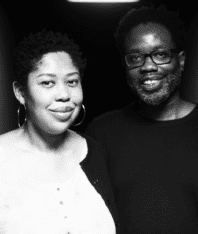
The Giwas
Black-Owned Brooklyn documents current local Black businesses, culture and history. How did you branch into filmmaking?
Tayo Giwa: Filmmaking is something we stumbled into in creating Black-Owned Brooklyn. We don’t actually have a formal background in it. We started off making our first short in 2020, “Soul Summit: Doin’ It in the Park.” Right after we finished, we enjoyed the experience so much that we were like, “We need to make another one.” So we immediately turned our attention to the story of The East, which we hear about a lot in our work.
What was it about The East?
Tayo: We learned about The East when writing about the International African Arts Festival on our Instagram account. Once we started digging into that history, we discovered it was hugely influential. We kept hearing references to it from people in the community. Long-term residents who we speak to frequently in doing Black-Owned Brooklyn tell us they were students who went to The East’s school or participated their in programs. We knew it was a huge story, but it was a history that really hadn’t been told as extensively and holistically as it should.
The East was born in 1969 out of the student protests that erupted across the world in 1968. How did that social upheaval of 1968 manifest itself in Brooklyn’s Ocean Hill-Brownsville neighborhood?
Cynthia Gordy Giwa: There’s a specific context to what was going on in New York City that birthed The East, and that was the community control experiment that was started in the mid-’60s. It was an opportunity for parents to decide on curriculum, the school’s missions, and also the hiring and firing of teachers or relocating teachers they didn’t think were doing a good job. It was the first time Black communities were allowed to make these decisions. They did community control in a number of different school districts throughout New York City, one of them being Ocean Hill-Brownsville, which is where Jitu Weusi was a teacher. He was one of the founders of The East.
When did community control end in Ocean Hill-Brownsville?
Cynthia: The New York City Teachers Union went on strike in 1968 in protest of some firings taking place. As a result of that strike, they basically had to overturn the whole community control experiment. That’s when Black teachers and students from that movement started to organize on their own, thinking of ways to create their own education system outside of the public school system. And that begat The East.
Tayo: When we talk about integration, it’s always moving Black students to white neighborhoods, and it’s never the other way around. So part of this community control experiment and the whole idea around The East was more about focusing on ourselves and our own community. Taking pride in our community and uplifting it. Not thinking that the only way that we can get a quality education is by being bused to white schools.
What was the immediate impact on the community?
Tayo: The East had this psychological explosion in the community in the sense that people were really impacted by this idea that we all have this greatness and we should believe in ourselves. We tried to show in the film that they created this sense of self, this positive identity, and an appreciation of our culture. And the community just devoured it and it empowered them. It empowered the children who came from that movement. That psychic shift, that empowerment, is this thing that you still see in Central Brooklyn today.
So Jitu Weusi’s vision for The East was to show the Black community in Central Brooklyn they already possess everything they need to create meaningful lives?
Tayo: Part of the brilliance of Jitu Weusi was reminding the community of all this talent we have. It’s no coincidence that one of the first things The East created was this jazz club on Claver Place in Bed-Stuy. You’re having the most brilliant talented jazz musicians in the world play at this club. And it’s no coincidence that it’s jazz. This is African-American classical music that is coming here to show the community the cultural brilliance we have.
The East started on Claver Place in this row house, which then they outgrew. Then they took over the Armory on what’s now known as the Marcus Garvey Armory. That shows you the scale of what they were doing. They were connected to the shops up and down Fulton, going into Bed-Stuy and Stuyvesant Heights.
Do any of the organizations The East created exist today? They made a food co-op, a magazine, a publishing company, restaurants, etc.
Cynthia: The International African Arts Festival still exists. They just celebrated 52 years in July. That started as a fundraiser for The East’s school, Uhuru Sasa Shule, or Freedom Now School.
Tayo: The community child care center Little Sun People comes to mind. They were founded in 1980 by Fela Barclift, one of the first teachers at Uhuru Sasa Shule. So when you think about what from The East is still here, think about the International African Arts Festival, but you also think about Little Sun People. Little Sun People is based on the ideas of what The East was trying to do. It’s not run by the East, but it is a child of that movement.
Cynthia: It’s no coincidence that Central Brooklyn has one of the highest concentrations of Black businesses. That mentality was sparked by The East.
Some people in the documentary say The East wasn’t tied to a single ideology so as not to exclude people. How did they hold so many different belief systems in one organization?
Tayo: The East organized itself around the Nguzo Saba, which are the principles of Kwanzaa, but they’re not dogmatic beliefs. The East was really about bringing everyone together, this idea of pan-Africanism. They weren’t trying to exclude others and say that you have to believe in this particular idea. It was more like us together makes us stronger.
Cynthia: Some of those principles are unity, collective work, responsibility and creativity. These are life principles, organizing principles that I think anyone can get behind. Leaning into those principles was an inclusive way of organizing themselves.
What other inspirations from The East live on in Brooklyn?
Tayo: You think of all these popular food co-ops in Brooklyn now and it’s associated with a certain upper-class crunchiness, right? Like rich white folks, and really, some of those ideas were first put into practice by Black folks trying to take care of the community in the 1970s. People took a lot of inspiration from The East and how they did it.
Cynthia: Sometimes people focus on that The East isn’t around anymore in this particular form, in perpetuity, and conclude it was a failed experiment. But it wasn’t necessarily the point for it to exist in this way for all time. The point is that it was sparking cooperation among people. It was changing Black minds and aspirations that would carry on from generation to generation. That was the design of The East.
“The Sun Rises in The East” is now streaming on Amazon Prime Video, Tubi, YouTube and Google Play.
You might also like 

















